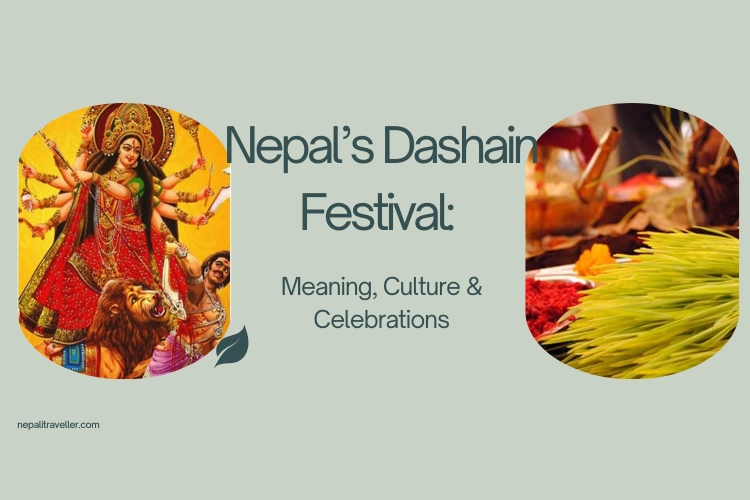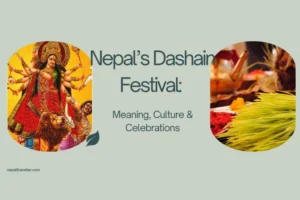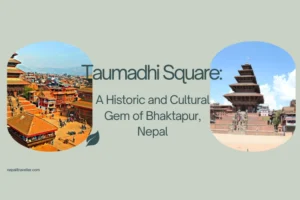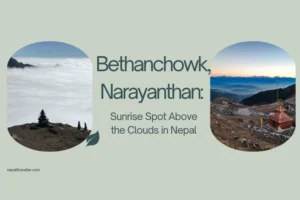Dashain or Vijaya Dashami is Nepal’s largest and biggest festival. Dashain is a very religious, cultural, and social festival that is one of rejoicing at the triumph of good over evil and one that unites Nepalese people regardless of castes, communities, and places. The 15-day grand celebration is done in the month of Ashwin in the Nepali lunar calendar, which occurs in September or October in the Gregorian calendar. Dashain is a colorful manifestation of heritage, family reunion, religious ritual, and celebratory gaiety that brings out the best of Nepal’s integral values and cultural heritage.
Table of Contents
ToggleHistorical and Mythological Significance
Dashain is rooted in an extremely old Hindu mythological past and religious practices that commemorate the victory of good over evil. The festival primarily honors Goddess Durga, the embodiment of divine feminine power and guard, who killed the ferocious demon Mahishasura in a nine nights and days’ battle. Mahishasura was a demon who possessed the power of shape-shifting and had become nearly invincible and was frightening gods and mortals alike. According to myth, it took a woman alone to be able to kill the demon, and so the gods combined their energies to create Durga, who went on to slay Mahishasura. This victory is still observed today as Dashain, which is the victory of good over evil and divine justice being served.
Again, another demon king Ravana is mythically killed by Lord Rama from the epic Ramayana. Rama’s triumph symbolizes the return of peace and good, yet again underlining the theme of moral goodness and force of good during the celebration.
Duration and Timing
Dashain continues for 15 days, from Ghatasthapana — the first day marked by celebration with the sowing of Jamara (holy barley grass) representing prosperity and life — through to Kojagrat Purnima, full moon day. Each day of Dashain is a religious importance and rituals, but the major days are the seventh (Fulpati), eighth (Maha Asthami), ninth (Maha Navami), tenth (Vijaya Dashami), and the fifteenth (Kojagrat Purnima).
The festival is governed by the lunar Bikram Sambat calendar, which positions Dashain in the glorious lunar half-month of Ashwin. This time of year also corresponds to the end of the monsoon and the start of comparatively cool weather, making it a great time for outdoor gathering and festivity.
Religious and Ritual Practices
Dashain is replete with rituals that tie people to religion and culture. The festival is all about worshipping, praying, and asking for blessings of good health, prosperity, and protection:
Ghatasthapana (Day 1)
The festival begins with Ghatasthapana, a sacred initiation ritual where a sacred pot (Ghata) is filled with fresh water and placed on a bed of sand in a dark room. Barley or millet seeds are sown on the pot and covered with earth to be grown as Jamara. The pot symbolizes Goddess Durga, and the sprouting Jamara represents new life and energy.
Fulpati (Day 7)
Fulpati marks the arrival of the royal procession and symbolic offerings to the goddess. A ceremonial procession headed by the Nepal Army, followed by bundles of flowers, banana stalks, and leaves called Fulpati, moves from Gorkha to Kathmandu to mark the arrival and might of the goddess. Houses are made and adorned to welcome these divine offerings.
Maha Asthami (Day 8) and Maha Navami (Day 9)
It is the day reserved for more worship and sacrifices, especially animal sacrifices, offered to Goddess Durga out of respect and to appease her divine powers. Durga temples and temples of her fierce incarnations such as Kali are visited in large numbers.
Vijaya Dashami (Day 10)
The tenth day is the culmination of the festival, the ultimate victory — Vijaya refers to victory, Dashami refers to the tenth day. Older family members put Tika — a mixture of vermillion paste, red rice, and yogurt — and Jamara on the foreheads of their younger kin. The custom bestows blessings, protection, and prosperity. Family members exchange gifts, relish traditional cuisine, and reassert love and respect.
Kojagrat Purnima (Day 15)
The celebration culminates with Kojagrat Purnima, the night of illumination. It is believed that goddess Lakshmi, the deity of prosperity and wealth, descends to bless all those who stay awake and pray all night. Houses are illuminated, and prayers are made to invite blessings for prosperity.
Social and Cultural Significance
Dashain is not just a religious event but a social cementing force and a source of cultural identity for Nepal. Dashain encourages communal harmony irrespective of caste, creed, or ethnicity, and is thus an inclusive festival like no other. The following happens during Dashain:
- Families reunite as their members return from urban centers and abroad to their hometowns.
- Hospitality is filled with feasts of traditional dishes such as goat meat (khasi ko masu), gundruk, and sel roti.
- New clothing serves as a celebration of change and new beginnings.
- Villages create swings called “Linge Ping” to participate in traditional recreation and amusement.
- The holiday serves as an excuse for people to let go of grievances and strengthen their relationships.
Dashain is also a time to reflect on moral and ethical values; further strengthening the Nepalese cultural lesson on justice, on taking care of their elders, and on their responsibility to their families.
Dashain Celebrations Around Nepal
Dashain is celebrated around the country, though the celebrations can differ with each region:
- In the Kathmandu Valley, we see long temple rituals, big celebrations, and animal sacrifices, where many people attend.
- In rural areas of Nepal, Dashain takes on a communal celebration wherein it is mixed with local customs.
- Ethnic Communities, such as the Newars, also have their own customs around Dashain; which they circle into the mainstream Hindu culture and celebrate.
- Families fly kites and eat outside for picnics; in the Terai region.
- Fire big bonfires is how some places celebrate, as they symbolize the elimination of evil.
Dashain and Environmental Concerns
In recent years, there has been a developing awareness of the ecological and animal welfare implications of certain Dashain practices, particularly with respect to animal sacrifice. There are growth in campaigns circling around celebrating Dashain in ways that are environmentally and animal friendly, rhetoric promoting symbolic sacrificial rituals, or a move to vegan offerings instead for commemorating Dashain.
Tips for Observing Dashain
If you plan to observe on Dashain in Nepal, whether as resident or as tourist, there are a few noteworthy points to consider:
- Take part respectfully in ceremonies, such as receiving Tika from elders.
- Traditional feasts with family members, being respectful of the customary way to partake and share traditionally prepared food.
- Participate in patriotic ceremonies in temples and of cultural significance with parades.
- Taste traditional sweets and special dishes prepared for Dashain.
- Be respectful of the anticipable and predictable cultural differences in the way Dashain is observed by various ethnic groups.
Conclusion
Dashain is a remarkable festival full of cultural nuance that embodies the essence of everything indicating – mythological, traditional, communal, and religiously pious. Dashain observes the eternal triumph of good over evil in a series of ceremonies and customs celebratory of community and family ties. Dashain is symbolically stable over generations which represents rich cultural heritage indicative of Nepalese values and community – its deference to faith, love and fellowship across generations.
Frequently Asked Questions (FAQs)
1. Can tourists take part in Dashain celebrations in Nepal?
Yes, tourists are encouraged to partake in Dashain celebrations. They can take part in traditional ceremonies, receive tika blessings, enjoy family feasts, and engage in cultural events such as kite flying and swing at community swings. Dashain provides a great cultural experience for people who are interested in experiencing Nepali history and culture.
2. What types of traditional foods are served during Dashain?
Dashain foods include khasi ko masu (goat and/or buffalo meat), sel roti (sweet rice bread), a variety of curries, and local vegetables. The foods are enjoyed with family and guests, which symbolizes abundance and celebration of the festival.
3. What is the effect of Dashain on tourism and the Nepalese local economy?
Dashain is the most busy tourist season in Nepal, both domestically and internationally. There is a revival and energy in the service and hospitality sector, local businesses, artisans, and transportation companies. Dashain will be a significant contributor to the economy of Nepal. Tourists can also engage in specially created packages and cultural tours, as a way to provide sustainable tourism development for Dashain.







